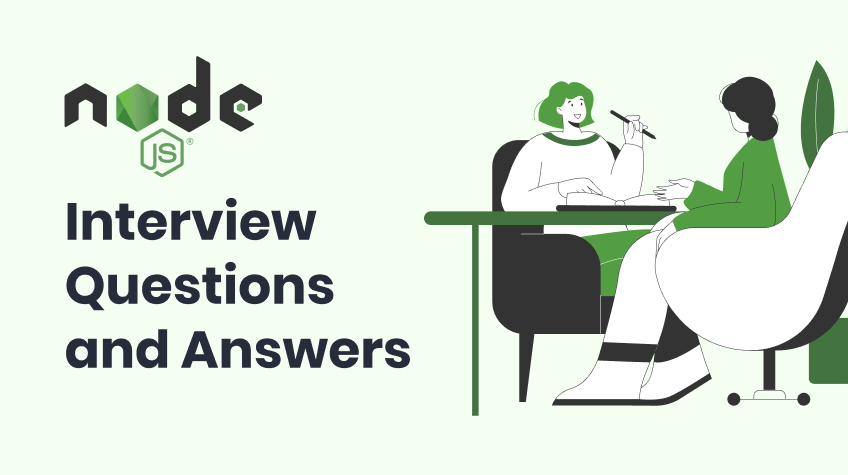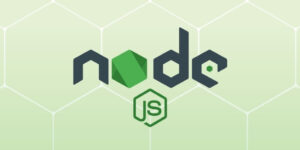
Introduction
In the dynamic realm of web development, Node js is revolutionizing how we build scalable and efficient server-side applications. As the demand for Node js developers continues to soar, Node js interview questions and answers become crucial milestones for showcasing expertise.
To help you navigate these pivotal moments, we’ve curated a comprehensive list of the top 25 Node js interview questions and answers. Whether you’re a seasoned developer or aspiring to dive into Node js, this resource aims to sharpen your knowledge and boost your confidence in facing the challenges of Node.js interviews. Discover the secrets of Node.js and ace those interviews!
Top 25 Node JS Interview Questions and Answers
Here are 25 Node.js interview questions and answers
1. What is Node js?
Node js is a runtime environment that executes JavaScript code on the server side. Its core features include a non-blocking, event-driven architecture that enables asynchronous operations handling. A single thread is used by Node js instead of traditional server-side technologies, optimizing performance by managing concurrent connections efficiently. This uniqueness makes Node js adept at handling real-time applications and scalable network-driven scenarios.
2. Explain the event-driven architecture of Node js?
Nodejs follows an event-driven architecture, utilizing a single-threaded event loop. This design allows asynchronous execution, enabling efficient handling of multiple tasks simultaneously. Events trigger callbacks, enhancing scalability and responsiveness in applications.
3. What is npm?
npm, or Node Package Manager, is a robust tool for managing Nodejs packages and dependencies. Developers leverage npm to install, share, and distribute packages, streamlining the integration of third-party libraries and modules into their projects.
4. How does Node js handle concurrent requests?
Nodejs manages concurrent requests through its non-blocking I/O model. Leveraging a single-threaded event loop efficiently handles multiple operations simultaneously, ensuring optimal performance in high-traffic scenarios.
5. What are Callbacks in Node js?
Callbacks are essential in Nodejs for handling asynchronous operations. They ensure that specific code runs only after the completion of a preceding operation, preventing blocking and promoting non-blocking behavior for efficient task execution.
6. Explain the concept of Promises in Node js
Promises provide an alternative to callbacks, offering a structured and cleaner way to handle asynchronous operations. They represent an operation’s eventual completion or failure and simplify the flow of asynchronous code.
7. What is the role of the ‘require’ function in Node js?
The ‘require’ function is pivotal in Nodejs for including external modules. It enables developers to modularize their code, enhance maintainability, and efficiently manage dependencies by importing necessary functionality into their applications.
8. How does Node js handle file systems?
Nodejs facilitates file system operations through its ‘fs’ module. Developers can read, write, and manipulate files seamlessly, enhancing the application’s ability to handle data and interact with external resources.
9. What is middleware in Express.js?
Middleware in Express.js acts as a bridge between incoming requests and application logic. It allows developers to customize the request-response cycle, performing tasks such as logging, authentication, and error handling in a modular and organized manner.
10. Explain routing in Express.js
Express.js routing defines how an application responds to specific HTTP requests. Developers can create routes to handle different endpoints, making organizing and structuring their applications easier while managing client requests efficiently.
11. What is the difference between process.nextTick() and setImmediate()?
Both process.nextTick() and setImmediate() in Nodejs execute a callback function but differ in timing. Process.nextTick() prioritizes execution at the end of the current event loop cycle, while setImmediate() executes in the following event loop cycle.
12. How can you handle errors in Node js?
Error handling in Nodejs involves techniques like try-catch blocks and utilizing the ‘error’ event. Proper error management ensures graceful handling of unexpected issues, preventing application crashes and improving overall robustness.
13. What is the purpose of the ‘Buffer’ class in Node js?
The ‘Buffer’ class in Nodejs is crucial for handling binary data. It provides a way to work with raw data, making it particularly useful for scenarios involving file systems, network operations, and other situations where binary data manipulation is required.
14. Explain the concept of streams in Node js
Streams in Node.js facilitate efficient data handling by breaking it into chunks and processing it sequentially. They enhance performance and memory efficiency, making them ideal for large datasets and real-time data transfer scenarios.
15. How does clustering work in Node js?
Node.js clustering involves the creation of multiple instances or worker processes to handle incoming requests. This improves application performance by utilizing all available CPU cores, effectively distributing the workload.
16. What is the purpose of the ‘child_process’ module?
The ‘child_process’ module in Node.js enables the creation and communication with child processes. This is valuable for executing external commands, parallelizing tasks, and enhancing the overall efficiency and responsiveness of the application.
17. How do you secure a Node js application?
Securing a Node.js application involves implementing best practices such as input validation, authentication, and authorization. By addressing potential vulnerabilities, developers can create robust and secure applications that safeguard against common security threats.
18. What is WebSocket in Node js?
WebSocket in Node.js facilitates real-time bidirectional communication between the client and the server. It establishes a persistent connection, enabling instant data exchange and making it suitable for applications requiring low latency and real-time updates.
19. Explain the concept of JWT (JSON Web Tokens) in Node js
JWT, or JSON Web Tokens, provides a secure method for transferring data between parties. In Node.js, they are commonly used for authentication by generating and verifying tokens, ensuring the integrity and authenticity of the transmitted data.
20. What is the purpose of the ‘os’ module in Node js?
The ‘os’ module in Node.js delivers details about the operating system. Developers can leverage this module to access details such as CPU architecture, memory, and network interfaces, allowing for platform-specific optimizations and configurations.
21. How to handle sessions in Express.js?
Handling sessions in Express.js involves using middleware like ‘express-session’ to manage user sessions. This ensures persistent user data across multiple requests and enhances security by preventing information exposure.
22. What is the purpose of the ‘net’ module in Node js?
Node.js’s ‘net’ module in Node.js facilitates network-related tasks, particularly in creating TCP servers and clients. Developers can utilize this module to build robust and scalable network applications.
23. How does garbage collection work in Node js?
The V8 engine manages garbage collection in Node.js. It recognizes and frees up memory occupied by objects no longer in use, ensuring optimal memory management and preventing memory leaks.
24. Explain the concept of the ‘eventEmitter’ class in Node js
The ‘eventEmitter’ class in Node.js is fundamental for handling events. It allows developers to create, emit, and listen for custom events, promoting a modular and decoupled architecture that enhances code organization and reusability.
25. Common debugging techniques in Node js
Debugging in Node.js involves various techniques, including console.log statements, the ‘debugger’ statement, and third-party tools like the Node.js Debugger. Familiarity with these methods empowers developers to identify and resolve issues efficiently, ensuring the robustness of their applications.
Also Read: Front End Developer Interview Questions and Answers
Conclusion
In the ever-evolving landscape of web development, mastering Node js is a gateway to unlocking unparalleled potential. These top 25 Node js interview questions and answers have equipped you with diverse knowledge, from event-driven architecture to securing applications and optimizing performance.
As you embark on your Node.js web development journey, remember that continuous learning is critical. Stay curious, explore beyond the confines of these questions, and embrace the challenges that come your way. With this newfound expertise, you’re well-positioned to navigate interviews, contribute to innovative projects, and shape the future of server-side development. Happy coding!






